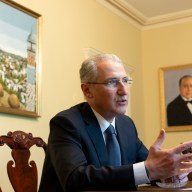Mankind has fantasized about it for centuries. One man accomplished it in four years: Building and flying an ornithopter, a human-powered aircraft with flapping wings capable of sustained flight.
Such is the achievement of Todd Reichert, engineering PhD candidate at the University of Toronto Institute for Aerospace Studies (UTIAS). On Aug. 2, he piloted an ornithopter dubbed the Snowbird (hpo.ornithopter.ca) to a world aeronautical record as the first of its kind to fly continuously.
Under Reichert’s control — a lot of hard pedalling — the 43-kilogram flyer with a whopping 32 metre wingspan clinched a historical first by maintaining stable altitude and airspeed for 19.3 seconds, crossing 145 metres at an average speed of 25.6 kilometres per hour. While the concept sounds radical, Reichert notes ornithopters have been, er, flying around in the theoretical world for some 500 years.
“The lab I work in does research on flapping flight,” he concedes, noting that feasibility tests were being run a few years ago. “If you’re working in that area, that thought is always there. It’s an age-old aeronautical dream so it didn’t just jump up.”
Once simulations — when coupled with overcoming structural challenges and ensuring his constitution was up for powering the beast —proved the notion possible, Reichert and a crew of five main participants committed to their design.
A few years and much learning about the practical side of aircraft building later, Reichert piloted the first human-powered aircraft Tottenham, Ontario’s Great Lakes Gliding Club.
While much of the attention goes to him, Reichert asserts that teamwork was what ultimately led to Snowbird’s success.
“This was not a one-man thing,” he declares. “There were quite a few people from U of T, UTIAS, exchange programs and community volunteers helping behind the scenes. The people we had that came together at the end were just stellar. That’s make-or-break for a project of this magnitude.”














